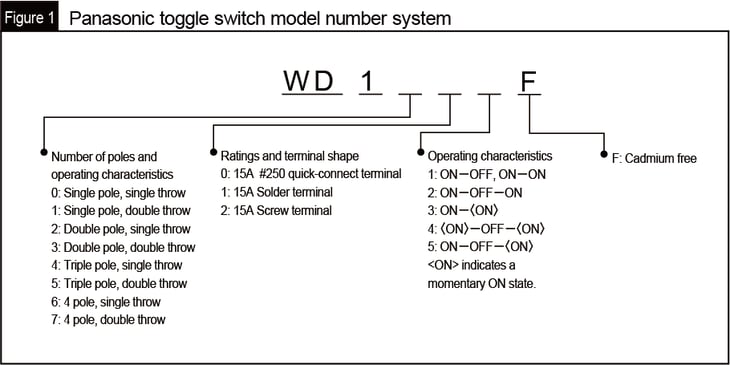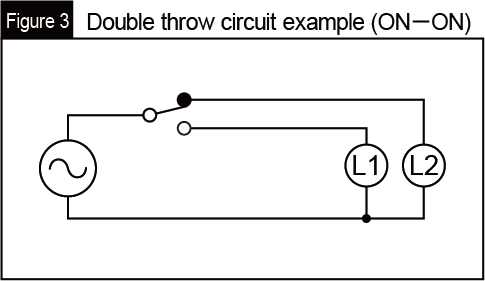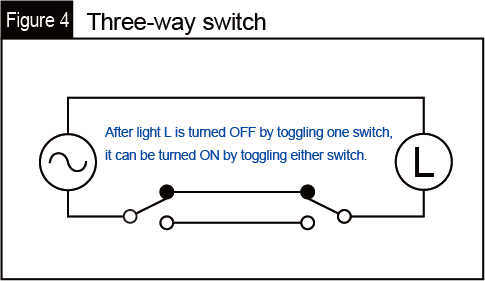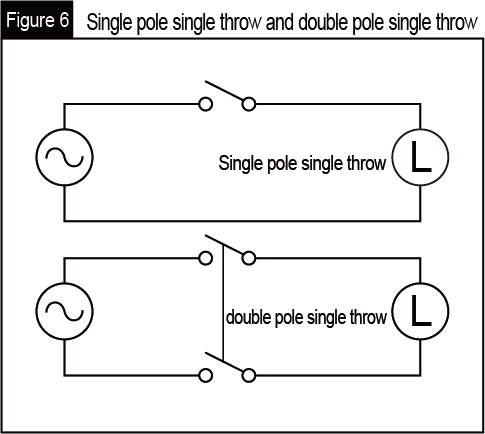In reply to customer questions, this article describes toggle switches ranging from the basics to contact types and designations. Please make use of this information and expand your knowledge of toggle switches.
|
Question: There are several designations of contact types, including "single pole single throw," "single pole double throw," "ON-OFF," and "ON-ON" type contacts. I do not have a proper understanding of the details and differences between them. In addition, can you elaborate on the relationship between them and the terms "single side cut off," "double side cut off," and "three-way switch"? Answer: The following descriptions explain the designations of generally used contact types and of the contact types used for our toggle switches. |
First, let's examine the basics of toggle switches. Toggle switches are generic switches that are turned ON and OFF by moving their levers. For example, to help you understand, imagine a scene from an old science fiction movie in which a robot or ship is being operated with switches, etc., whose levers were moved up and down with a snapping sound.
Next, let's have a look at the designations of generally used contact types and of the contact types used for our toggle switches.
As shown in Figure 1, the designations of Panasonic toggle switches are specified using the combination of the "number of poles and operating characteristics." Use examples include "single pole, single throw," "single pole, double throw," "double pole, single throw," and "double pole, double throw." In addition, the designations of ON-ON and ON-OFF, etc. are used for indicating the operating characteristics. This type of information can be assessed through figures representing model numbers.

First, the following descriptions explain the differences between the terms single throw and double throw of "the number of poles and operating characteristics."
In general, the following contact methods are used for switches.
- Form A contacts (called normally open (NO) contacts)
- Form B contacts (called normally closed (NC) contacts)
- Form C contacts structured by combining Form A and Form B contacts
Even the same contact method has various names.
Form A contacts are normally OFF, which doesn't allow any current to flow in the switch circuit, and turn ON to allow current to flow when the switch is toggled.
Form B contacts work in the opposite way. They are normally ON, but disconnected to turn OFF when the switch is toggled. For example, this type of switch is used for an emergency shutdown in the event of anomalies.
Form C contacts are normally ON as is the case with Form B contacts. When one pair of contacts are ON, toggling the switch turns another pair of contacts ON to switch to other operation.
Table 1 provides an easy-to-understand summary of the differences between Form A, Form B, and Form C contacts.

As seen in Table 1, the designations "single throw" and "double throw" used for toggle switches refer to Form A contacts and Form C contacts, respectively.
The toggle switch designations in Table 1 include the notation "ON-OFF." This corresponds to "single throw" contacts, which constitute a circuit turned ON and OFF by a toggle switch as shown in Figure 2. For example, this type of single throw contact is used for turning lights ON and OFF.

On the other hand, the designations "ON-ON" and double throw correspond to the same contact circuit structure, which is used for switching circuit loads as shown in Figure 3. This structure allows the adjustment of brightness or a machine's driving force. For example, to help you understand, imagine lighting where L2 normally lights up, and is turned OFF before L1 is turned on by toggling the lighting switch.

To build a circuit used when stairwell lighting is switched on and off by two switches, one upstairs and one downstairs, a three-way switch structure is used as shown in Figure 4. Form C contacts are applied to this circuit, achieving a structure that allows either switch to turn the lights ON-OFF.

Figure 5 shows ON-OFF-ON type Form C contacts (double throw). Since the lever of this toggle switch can be stopped at the middle position, both circuits L1 and L2 can be turned OFF. This double throw circuit is used when switching between high-output, low-output, and off states is necessary for ventilation fans and electric fans, for example.

Finally, the number of poles is explained.
First, the term "single pole" refers to a circuit consisting of one pair of either Form A or Form B contacts. The term "double pole" refers to a circuit consisting of two pairs of either Form A or Form B contacts.
Figure 6 shows examples of the use of single pole single throw contacts and double pole single throw contacts. In Figure 6, the upper circuit is also referred to as a single side cut off type, while the lower circuit is also referred to as a double side cut off type since both pairs of contacts can be turned OFF by turning OFF the switch containing these contacts.

For your information, a contact type consisting of double pole and Form C contacts refers to a double pole double throw structure. When switching multiple circuits simultaneously by the single toggling of a switch, this type of multiple-pole switch is used.
How did you go with the explanations above? This course explained toggle switch circuits, including their basic points and variants.
At first glance, the operation of toggle switches seems monotonous; however, there are also switches that actually allow multiple types of control internally. Please make use of the above information when designing circuits, including the principle of toggle switch operations.
Keyword in this article
- Contact: A contact refers to a point of contact to allow current to flow in circuits.
- ON state: The ON state refers to the state in which a circuit is closed and allows electric signals to flow for its operation.
- OFF state: The OFF state refers to the state in which a circuit is cut off to break electric signals and stop its operation.





